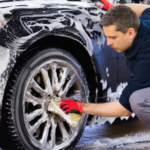For a new firearms owner, knowing your weapon is vital. Talking about the parts of a gun incorrectly or not knowing how they work can not only make you look stupid but have grave consequences.
To help you in this process, we have broken down the parts of a rifle into a handy to read guide. We go through the various parts, types of rifles, and delve into the world of sight and scopes.
What Defines a Rifle?
Rifles are large firearms with long barrels. They get their name from the effect of turning the bullet when projected down the barrel. This increases accuracy and is named rifling like AR-15 rifles
Rifles always fire one single piece bullet at a time. They are stable, effective, and reliable guns used for long-range, accurate shooting such as hunting and sniping. They can use various calibers of ammunition. For environmentally-conscious shooters, it’s important to get top quality lead-free Ammo to minimize the impact on the environment.
Click here – How Much Does a Mobile Office Usually Cost?
Action and the Parts of a Rifle
The action is the most important part of the rifle, as it is where the major functions take place. Loading and firing both happen here, along with the combustion that propels the bullet along with the chamber. It is usually around the midway point on your gun.
The main section of the action is the hammer, trigger, and bolt. It will load a cartridge, hit the bullet with the hammer then eject the shell. It is imperative that the action is always well maintained.
Visit here to know about oem glock parts
Trigger
The trigger is the bridge between you and the gun. Once you pull it, the shot fires and discharged from the barrel. It is a curved piece of metal that comes in multiple variations such as dual-stage and drop-in types.
Trigger Guard
The trigger guard prevents accidental discharge of the gun. It is a metal loop that protects the trigger and finger. It can also help orientation, allowing the firer to find the trigger quickly without having to look down at the weapon.
Visit here to know about second focal plane.
Bolt
The bolt is within the action and is responsible for the firing mechanism. It is a pin that fires the actual bullet. The casing is then removed by the extractor and expanding gas. A new bullet is then brought back into place by the pulling of the bolt handle.
Bolt Handle
The bolt handle is usually situated above the trigger on the action. When pulled, it moves the rounds back into place so a bullet is in the chamber ready for you to fire. It is also known as the charging handle. Let’s know about 223 remington.
Safety Lock
The safety lock prevents accidental discharge in the barrel. Once locked, it will prevent your trigger from moving, so even if a loaded gun will not fire. The safety lock must always be on when the gun is not needed, such as in transportation and storage.
Magazine
A magazine is a cartridge containing your bullet, that clips into your rifle. Without it, your gun would have no ammunition to fire. A set of bullets inside the magazine is a round.
Click here – 5 Reasons Why Personalized Gifts Are the Best
Chamber
The chamber is the section of the gun where the bullet sits ready to fire. It is the point where the pin will hit, ejecting the bullet down the barrel and the bullet body will separate from the cartridge.
Sights
Most rifles will have a front and rear sight aligned to help you take aim. Some rifles may have increased sights or externally added devices on top of the gun to assist.
The Different Action Types
Rifles come with a wide array of different actions, each with their own characteristics and ways of operation. They are as follows;
Bolt
Bolt action guns are very common. You pull the bolt back, it releases the spent cartridge and places a new bullet in the chamber. In many cases, the bolt is removable for safety reasons.
Pump Action
This is more common in shotguns, though it can be very useful in rifles as you do not need to move your hands from the stock to reload. Pushing the pump forward loads the gun while pumping it back unloads it.
Lever Action
Pushing down and forward will operate a lever present on these rifles. It will eject the cartridge from the barrel in the same way you would get with a bolt action. For safety, it is best to push the lever back and forth multiple times to check no bullets are in the barrel.
Break Action
In a break-action gun, shells and cartridges load via the back of the gun into the butt. This snaps down like a door hinge, allowing you to restock the weapon. A hammer, similar to a lever-action gun, operates it.
Semi-Automatic
In a semi automatic, gases used to fire the bullet down the chamber are also used to expend and reload the next cartridge. Just like a pump-action, this allows you to keep taking shots without removing your hands from the gun.
Revolver
Revolving action is the mechanism you would see on a classic six-shooter. It has a round barrel into which you place ammunition. Each time the gun fires, the barrel rotates and pushes another into place.
Stock
The stock is the large end of the rifle. It is there to provide stability when shooting and tucks into the shooter’s arm. It also allows a more effective aim and can take some of the impact away from recoil.
Traditionally, stocks are from wood and many still are. However, tough modern plastics can also replace a traditional wooden stock. Some stocks fold down, are removable or can house equipment such as the excellent Magpul stock.
The Butt
The part of the stock that tucks into your arm is the butt. This is the part of the stock that will transfer much of the impact from the firing into your shoulder.
Sling Stud
The gun will have two sling studs, one under the stock and another under the forestock. They are used for threading your sling through so you can carry your rifle comfortably.
Barrel
The barrel is the hollow shaft that the bullet moves down once it has been fired from the action. The barrel has an internal spiral pattern so that the bullet spins when it leaves the chamber. This makes it travel further and gives it more accuracy.
Muzzle
The end of the barrel where the bullet exits is called the muzzle. Longer barrels give increased accuracy and they do often come in various thicknesses.
Forestock
The forestock is under the barrel. It will either be made from wood or polymer and is a large area that is used for allowing a second hand to grip the weapon, increasing stability.
Rifle Scopes
A scope is a device that fits the top of a rifle. It enhances vision and allows for increased accuracy, usually with the use of aligned crosshairs or lasers. A scope is invaluable if you are looking for highly accurate shots.
The Lens
The lenses are the most important parts of a rifle scope as they are essentially your enhanced vision. The lens furthest away from the stock is the objective lens. This is always the larger of the two.
The ocular lens is the one closest to the stock, that the shooter will use to look through. The objective lens takes light and passes it back through the scope to the ocular lens.
The casing containing the larger lens is the objective bell, while the ocular lens housing is known as the eyepiece. They work in conjunction to amplify the image, increasing accuracy. They do this in a similar fashion to how a telescope works.
Light enters through the objective lens. This is sent to a particular point in the scope and it is then magnified by the ocular lens. This image is then transmitted in a normal manner to the shooter’s retina.
You should also read about Glock 32 if you’re interested to learn about a compact and easy to carry gun”
Crosshair
To increase accuracy, rifle scopes also have a crosshair, also known as the reticle. This marker can be seen when looking down the lens and increases accuracy, telling the shooter exactly where their shot will land.
Choosing a Rifle
Now you have read our handy guide to the parts of a rifle, it is time to go out and try some to see which best suits you. Visit a local shooting range and ask what they have to test out before visiting your local gun store for advice, or better yet build one of your own using 5D’s selection of 80 lowers.
If you still have questions, we can answer almost anything on our website. AskCorran has a number of handy hint and guides, so check out our articles today for help with any lifestyle advice you need!






